Related Research Articles

A cruiser is a type of warship. Modern cruisers are generally the largest ships in a fleet after aircraft carriers and amphibious assault ships, and can usually perform several roles.
Henry Adrian "Packy" Schade was a United States Navy officer, naval architect, and professor.

The United States Fleet Forces Command (USFF) is a service component command of the United States Navy that provides naval forces to a wide variety of U.S. forces. The naval resources may be allocated to Combatant Commanders such as United States Northern Command (USNORTHCOM) under the authority of the Secretary of Defense. Originally formed as United States Atlantic Fleet (USLANTFLT) in 1906, it has been an integral part of the defense of the United States of America since the early 20th century. In 2002, the Fleet comprised over 118,000 Navy and Marine Corps personnel serving on 186 ships and in 1,300 aircraft, with an area of responsibility ranging over most of the Atlantic Ocean from the North Pole to the South Pole, the Caribbean Sea, Gulf of Mexico, and the waters of the Pacific Ocean along the coasts of Central and South America.
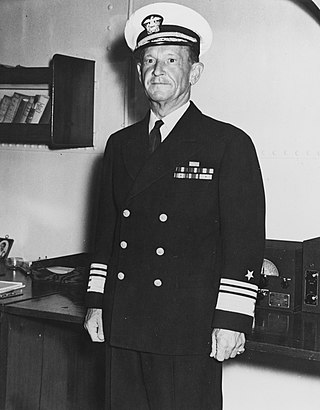
Frank Jack Fletcher was an admiral in the United States Navy during World War II. Fletcher commanded five different task forces through WWII; he was the operational task force commander at the pivotal battles of the Coral Sea and Midway, which collectively resulted in the sinking of five Japanese fleet carriers.
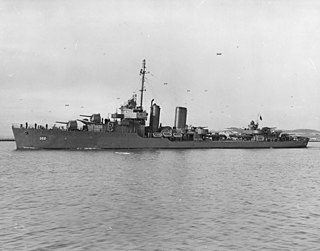
The third USS Worden (DD-352) was a Farragut-class destroyer in the United States Navy during World War II. She was named for John Lorimer Worden.
The Bureau of Naval Weapons (BuWeps) was part of the United States Navy's material organization between 1959 and 1966, with responsibility for procurement and support of naval aircraft and aerial weapons, as well as shipboard and submarine naval weapons. The bureau was established August 18, 1959, by an Act of Congress. The Act merged the Bureau of Aeronautics (BuAer), which had responsibility for naval aircraft and related systems, and the Bureau of Ordnance (BuOrd), which had responsibility for naval weapons.
The Bureau of Construction and Repair (BuC&R) was the part of the United States Navy which from 1862 to 1940 was responsible for supervising the design, construction, conversion, procurement, maintenance, and repair of ships and other craft for the Navy. The bureau also managed shipyards, repair facilities, laboratories, and shore stations.

Naka (那珂) was a Sendai-class light cruiser in the Imperial Japanese Navy (IJN), named after the Naka River in the Tochigi and Ibaraki prefectures of eastern Japan. Naka was the third vessel completed in the Sendai class of light cruisers, and like other vessels of her class, she was intended for use as the flagship of a destroyer flotilla.

Agano (阿賀野) was the lead ship of her class of four light cruisers built for the Imperial Japanese Navy (IJN) during World War II. Completed in 1942, she escorted a troop convoy to New Guinea in December. In early 1943 the ship participated in Operation Ke, the evacuation of Japanese troops from Guadalcanal. Six months later Agano transported troops and supplies to New Guinea and she played a minor role in the Battle of Empress Augusta Bay in early November. A few weeks later, the ship was badly damaged by American airstrikes and she sailed for Truk under her own power the following day. While en route, Agano was torpedoed by an American submarine and had to be towed to her destination. After several months of repairs, she left for Japan, but was intercepted and sunk by another American submarine in February 1944. Most of her crew was rescued by her escorting destroyer, but that ship was sunk with the loss of most of her crew and all of Agano's survivors by an American airstrike the following day.

Nagara (長良) was the lead ship of her class of light cruiser in the Imperial Japanese Navy. She was named after the Nagara River in the Chūbu region of Japan.

Suzutsuki (涼月) was an Akizuki-class destroyer of the Imperial Japanese Navy. Her name means "Clear Moon ". Suzutsuki is best known for her participation in Operation Ten-Go as one of the battleship Yamato's eight escort ships, where her bow was blown off by an American torpedo. Suzutsuki survived the battle, and escaped American forces by reversing all the way back to port. She was used as a breakwater until 20 November 1945, when her name was struck from the naval register and she was sold for scrap soon after. Suzutsuki was the longest living Akizuki-class destroyer.

Jintsū (神通) was the second vessel completed in the three-ship Sendai-class light cruiser in the Imperial Japanese Navy (IJN), named after the Jinzū River in the Gifu and Toyama prefectures of central Japan. She was active in World War II in various campaigns including the Japanese invasion of the Philippines, the Battle of the Java Sea, and Battle of Midway. On 13 July 1943 in the Battle of Kolombangara, she was discovered during a night attack by American ships and sunk in combat.
The Bureau of Steam Engineering was a bureau of the United States Navy, created by the act of 5 July 1862, receiving some of the duties of the former Bureau of Construction, Equipment and Repair. It became, by the Naval Appropriation Act of 4 June 1920, the Bureau of Engineering (BuEng). In 1940 it combined with the Bureau of Construction and Repair (BuC&R) and became the Bureau of Ships (BuShips).

Admiral Samuel Murray Robinson was a United States Navy four-star admiral who directed Navy procurement during World War II.
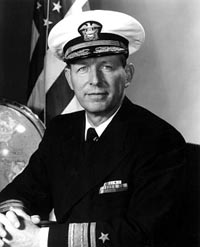
Albert G. Mumma was a rear admiral in the United States Navy who played a pivotal role in the development of nuclear propulsion for warships. During World War II, he served in France and Germany with the Alsos Mission.
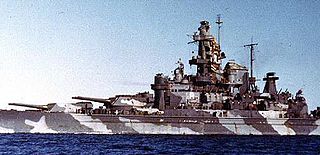
In 1935, the United States Navy Naval Research Laboratory began studies and tests on low visibility ship camouflage. Research continued through World War II to (1) reduce visibility by painting vertical surfaces to harmonize with the horizon and horizontal surfaces to blend with the sea, or (2) confuse identity and course by painting obtrusive patterns on vertical surfaces. Some camouflage methods served both purposes. American captains were permitted less freedom of interpretation with these schemes than their British Commonwealth counterparts applied to Admiralty camouflage schemes.

A naval division is a subdivision of a squadron or flotilla. It can also be a subdivision of a fleet. A division is the smallest naval formation, most commonly numbering between two and four ships.
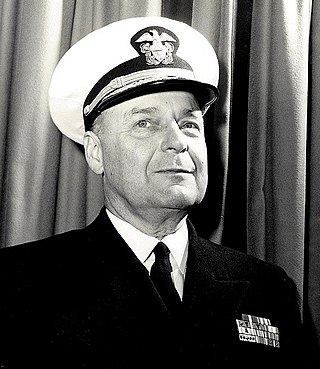
Harry Bean Jarrett was a highly decorated officer in the United States Navy with the rank of Vice Admiral. A veteran of several campaigns in Pacific during World War II, he distinguished himself during the Battle of the Coral Sea in May 1942, while commanding destroyer Morris and received the Navy Cross, the second highest decoration of the United States military.
Lynne Cline Quiggle was a rear admiral of the United States Navy. He saw service in World War II and in the Cold War before he was lost at sea in 1958.
References
- ↑ Furer, Julius Augustus (1959). Administration of the Navy Department in World War II. Washington, DC: Government Printing Office. pp. 217–222.
- ↑ Furer, pp. 222-227
- ↑ Silverstone, Paul H. (1965). U.S. Warships of World War II. London: Ian Allan Ltd. p. 13.
- ↑ Furer, pp. 228-230
- ↑ Furer, pp. 229-232
- ↑ Silverstone, p. 13
- ↑ Furer, pp. 246-254
- ↑ Furer, pp. 260-261
- ↑ Friedman, Norman (1994). U.S. Submarines Since 1945: An Illustrated Design History. Annapolis, Maryland: United States Naval Institute. pp. 101–107. ISBN 1-55750-260-9.
- ↑ Sharma, A. and Belokar, R. M., Achieving Success through Value Engineering: A Case Study, Proceedings of the World Congress on Engineering and Computer Science 2012 Vol II, accessed 27 December 2021